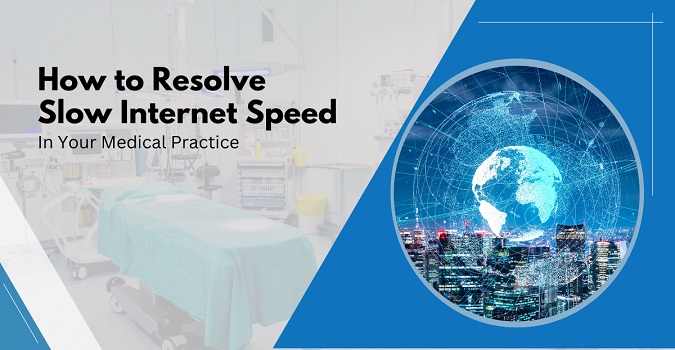In today’s modern era, medical practice is no longer limited to doctors, nurses, and patients;…

How to Resolve Slow Internet Speed in Your Medical Practice
Slow internet speed can significantly disrupt the operations of medical practice, impacting everything from delays in accessing electronic health records (EHRs), choppy telehealth appointments, and sluggish communication all stem from a sluggish network. In this blog, we will outline the steps to diagnose and resolve slow internet speeds, ensuring that your medical practice maintains efficient and reliable internet connectivity.
How To Diagnose and Fix Slow Internet Speed Issues?
A slow internet connection can be frustrating, especially when you’re trying to work, stream, or simply browse the web. Here are some common causes of slow internet speed and steps to diagnose and fix them:
Check Your Internet Speed
The first step in addressing slow network speeds is to determine the current speed of your connection. Use online speed test tools like speedtest.net or fast.com to measure your download and upload speeds. Compare these speeds with what you are paying for to identify any discrepancies.
Restart Your Devices and Router
Sometimes, the simplest solution is the most effective. Restart your devices, including computers, smartphones, and tablets, and power cycle your router by turning it off, waiting a few minutes, and then turning it back on. This can clear temporary glitches and improve internet connectivity.
Diagnose Wi-Fi Interference
Wi-Fi interference from neighbouring networks, electronic devices, or physical obstructions can significantly impact internet speeds. Use Wi-Fi analyser apps to identify the optimal channel for your network and minimise interference. Strategically place your router in a central location to improve coverage and reduce dead zones.
Update Router Firmware and Drivers
Outdated router firmware and device drivers can contribute to slow internet speeds and security vulnerabilities. Regularly check for firmware updates for your router and install them as needed. Ensure that the router and modem are running the latest firmware to fix known bugs and improve performance.
Optimise Network Configuration
Quality of Service (QoS) Settings: Implement QoS settings on your router to prioritise critical healthcare applications over less important traffic. This ensures that essential operations like accessing EHRs and telehealth services are not disrupted.
Network Segmentation: Segment your network to separate critical applications from non-essential traffic, ensuring that bandwidth is allocated efficiently.
Sufficient Bandwidth
Ensure that you have a high-speed internet plan that meets your practice’s requirements. Upgrading to a higher-speed plan can help accommodate the demands of your network. Installing additional routers or access points can improve coverage and ensure a more stable connection throughout the facility.
Check for Physical Issues
Inspect all cables and connections for any signs of damage or loose connections. Ensure that the router and modem are properly connected and functioning correctly.
Contact Your Internet Service Provider (ISP)
If you have followed the above steps and still experience slow internet speeds, contact your ISP for assistance. Report any persistent issues and request technical support if necessary. Your ISP can troubleshoot connectivity issues from their end and provide solutions to improve your internet experience.
Consider Professional IT Assistance
If persistent issues continue despite your efforts, consider partnering with a specialised IT support services provider like MedicalIT.Services. These services can provide proactive monitoring, security solutions, and IT consulting tailored to your medical practice’s needs.
The Role of MedicalIT.Services:
MedicalIT.Services specialises in providing IT solutions tailored to the healthcare industry. Here’s how they can assist in resolving slow network speeds:
High-Speed Internet Plans: They can help you upgrade to a high-speed internet plan that meets your practice’s requirements, ensuring sufficient bandwidth for all operations.
Network Optimization: They can assist in optimising your network configuration, including implementing QoS settings and network segmentation to prioritise critical healthcare applications.
Regular IT Maintenance: The company provides regular IT maintenance services, including updating router firmware and drivers, to ensure your network remains stable and secure.
24/7 IT Support: They offer 24/7 IT support, providing real-time assistance to resolve any IT issues promptly.
Conclusion
Slow network speeds can significantly impact the efficiency of your medical practice. By identifying the source of the problem, upgrading your internet plan, optimizing hardware, minimizing congestion, and performing regular maintenance, you can improve your network performance. For specialized support and reliable connectivity, consider reaching out to an NBN internet services provider that offers tailored solutions to meet the unique needs of medical practices.
Also Read:



